从语篇分析的角度看翻译中的对等
论翻译中的语域对等
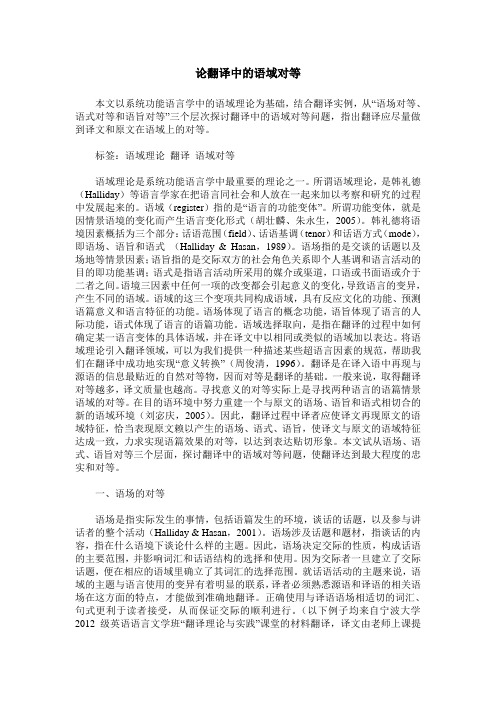
论翻译中的语域对等本文以系统功能语言学中的语域理论为基础,结合翻译实例,从“语场对等、语式对等和语旨对等”三个层次探讨翻译中的语域对等问题,指出翻译应尽量做到译文和原文在语域上的对等。
标签:语域理论翻译语域对等语域理论是系统功能语言学中最重要的理论之一。
所谓语域理论,是韩礼德(Halliday)等语言学家在把语言同社会和人放在一起来加以考察和研究的过程中发展起来的。
语域(register)指的是“语言的功能变体”。
所谓功能变体,就是因情景语境的变化而产生语言变化形式(胡壮麟、朱永生,2005)。
韩礼德将语境因素概括为三个部分:话语范围(field)、话语基调(tenor)和话语方式(mode),即语场、语旨和语式(Halliday & Hasan,1989)。
语场指的是交谈的话题以及场地等情景因素;语旨指的是交际双方的社会角色关系即个人基调和语言活动的目的即功能基调;语式是指语言活动所采用的媒介或渠道,口语或书面语或介于二者之间。
语境三因素中任何一项的改变都会引起意义的变化,导致语言的变异,产生不同的语域。
语域的这三个变项共同构成语域,具有反应文化的功能、预测语篇意义和语言特征的功能。
语场体现了语言的概念功能,语旨体现了语言的人际功能,语式体现了语言的语篇功能。
语域选择取向,是指在翻译的过程中如何确定某一语言变体的具体语域,并在译文中以相同或类似的语域加以表达。
将语域理论引入翻译领域,可以为我们提供一种描述某些超语言因素的规范,帮助我们在翻译中成功地实现“意义转换”(周俊清,1996)。
翻译是在译入语中再现与源语的信息最贴近的自然对等物,因而对等是翻译的基础。
一般来说,取得翻译对等越多,译文质量也越高。
寻找意义的对等实际上是寻找两种语言的语篇情景语域的对等。
在目的语环境中努力重建一个与原文的语场、语旨和语式相切合的新的语域环境(刘宓庆,2005)。
因此,翻译过程中译者应使译文再现原文的语域特征,恰当表现原文赖以产生的语场、语式、语旨,使译文与原文的语域特征达成一致,力求实现语篇效果的对等,以达到表达贴切形象。
从语篇分析的角度看翻译中的对等

从语篇分析的角度看翻译中的对等翻译是语言之间的桥梁,它使我们能够理解和欣赏不同语言的文化和思想。
在翻译过程中,对等是最基本也是最核心的概念之一。
本文将从语篇分析的角度来探讨翻译中的对等。
在翻译中,对等关系主要有两种,即文本内对等和文本间对等。
文本内对等是指源语篇和目标语篇在语篇层面上的对等,这种对等的是语言内部的关系,例如句法、词汇和语义等。
而文本间对等则是指源语篇和目标语篇在超语篇层面上的对等,这种对等的是语言之外的因素,例如文化、背景和意识形态等。
从语篇分析的角度来看,翻译中的对等主要体现在以下几个方面:文本功能文本功能是指语言在特定语境中所起的作用。
在翻译中,源语篇和目标语篇的文本功能应该尽可能地一致,这样才能保证翻译的准确性。
例如,原文中的警告、提示和呼吁等功能在翻译后应该保持不变。
文本结构文本结构是指语篇的宏观组织形式,例如叙事结构、论证结构和描述结构等。
在翻译中,源语篇和目标语篇的文本结构应该尽可能一致,这样才能保证翻译的流畅性和连贯性。
例如,在翻译小说时,应该注意情节的展开、人物形象的塑造和场景描写等方面,保持原文的叙事结构。
文本风格文本风格是指语言的表达方式和修辞手法,例如用词、句式、语气和修辞等。
在翻译中,源语篇和目标语篇的文本风格应该尽可能一致,这样才能保证翻译的艺术性和审美性。
例如,在翻译诗歌时,应该注意韵律、节奏和意象等方面,保持原文的修辞手法和表达方式。
在翻译中,对等并不是绝对的,而是具有一定的自由度。
这种自由度允许译者在翻译过程中进行适当的调整和变通,以适应目标语言的习惯和文化背景。
然而,这种自由度并不是无限制的,它必须以保证翻译的准确性和忠实性为前提。
自由度在翻译中的重要性不言而喻。
在保证对等的前提下,适当的自由度可以使翻译更加流畅、自然和易于理解。
它可以帮助译者更好地把握原文的精髓,并将其融入目标语言的语境和文化中。
同时,自由度还可以使译文更具创造性和艺术性,为读者带来全新的阅读体验。
浅析语篇分析在翻译中的应用

浅析语篇分析在翻译中的应用语篇分析是指对一段文本的整体结构、语言风格、情感色彩等方面进行分析和研究,以获得更全面、准确的理解和认知。
在翻译中,语篇分析是非常重要的环节,能够帮助译者更好地理解原文的意思和文化背景,并将其传递到译文中。
本文将从以下几个方面浅析语篇分析在翻译中的应用。
一、把握文本的整体结构翻译过程中,译者需要先对原文进行整体把握,确定其主旨、结构、脉络等。
只有了解原文的整体结构,才能更好地对单词、短语、句子等进行翻译,使译文和原文在结构上相似或相当。
同时,了解原文的结构还可以帮助译者判断某些重要信息可能出现的位置,以便更好地进行翻译。
二、考虑语言风格和情感色彩语言风格和情感色彩也是语篇分析的重要内容。
在进行翻译过程中,译者需要根据原文的语言风格和情感色彩,选择合适的词汇、句式、篇章结构等,使译文能够传递原文的情感和意味。
例如,如果原文使用了幽默或讽刺的语言风格,译者需要在翻译中保持这种风格,以便更好地传达原文的意思。
三、考虑文化差异语篇分析也可以帮助译者了解原文背后的文化背景和意义。
在进行翻译时,译者需要考虑源语言和目标语言之间的文化差异,尤其是在某些具有特定文化含义的短语、俚语、习语等方面。
只有深入了解原文和目标文化之间的差异,才可以进行更准确的翻译,避免语义上的错误和误解。
总之,语篇分析在翻译中的应用非常广泛,对于提高翻译质量和效率都有很大的帮助。
译者需要通过对原文的整体把握、语言风格和情感色彩的分析以及文化差异的认知,使译文不仅符合原文的意思和结构,而且传递了原文的文化背景和情感色彩。
语篇特征分析对翻译过程中动态对等的启示

语篇特征分析对翻译过程中动态对等的启示
赵鹏
【期刊名称】《济源职业技术学院学报》
【年(卷),期】2009(8)4
【摘要】对于译者而言,如何在翻译中全面地理解原文信息,并进行解码事关译文的质量好坏.而在解码过程中如何达到动态对等,成为摆在广大译者面前的一道难题.本文从语篇分析理论入手,探讨如何用语篇分析理论来把握动态对等,进而有效地进行信息解码,指导英汉翻译实践.
【总页数】3页(P58-60)
【作者】赵鹏
【作者单位】新乡学院,外国语学院,河南,新乡,453003
【正文语种】中文
【中图分类】H059
【相关文献】
1.英汉商务语篇翻译:文本功能与文化动态对等 [J], 张筠艇;
2.语篇翻译动态对等模式的认知关联阐释 [J], 田俊
3.谈英汉翻译过程中的动态对等 [J], 熊云凤;田喜娥
4.英汉商务语篇翻译:文本功能与文化动态对等 [J], 张筠艇
5.评价理论对叙述式广告语篇翻译的启示——叙述式广告语篇翻译的个案研究 [J], 黄秋文;黎珍
因版权原因,仅展示原文概要,查看原文内容请购买。
语篇特征分析对翻译过程中动态对等的启示

者 和译文 信息之 间 的关 系 , 该 与原 文接 收 者 和 应
原 文信息 之间 的关 系基本 相 同” 。奈 达对 翻译 J
鹏 (9 9一) 男 , 17 , 河南 济 源 人 , 乡学 院 外 国 语学 院讲 师 , 南 师 范 大 学 在 读 硕 士 , 究 方 向 为 翻 译理 论 新 河 研
nt i nu g ,u wt cnet”2毋 庸 置 疑 , o t l gae b t i ot 。 [ wha h x j 语义离 不开语境 , 任何篇 章都 是一定语 境 的产 物 , 任何 翻译 都是 建 立在 对语 境 的操 控 之 上 。因 此 , 对语境进 行诠 释可 以帮助译者 全面理 解原文 。 语境 这 一 概 念 最 早 由 英 国 人 类 学 家 B .
题 , 仍未 达成共识 。 至今
王 克非先 生 曾谈 到 , 翻译 的认 识集 中起 来 对
有两 点 , 一 是关于 翻译 是 一 种怎 样 的活 动 , 是 “ 一
关 于翻译 是 一 种 什 么 性 质 的 活 动 ” 。对 此 , 不
同的学者根 据 自己的研究 提 出了不 同的论 点 。
语 篇 分 析 (dso r a a s 或 t t i us nl i c e ys e x
点 以及 交 际方 式决 定 。文 化语境 是语篇所 涉及 的
l gii ) 0世纪 6 代问世 以来 , 到语言 i usc 自2 n ts 0年 受
学界 的巨大关 注 。近年 来 , 翻译 界 也 逐步 将 其 引
语 篇特 征 分析 对 翻译 过 程 中动态 对 等 的 启示
赵 鹏
( 乡学 院 外 国语 学 院 , 南 新 乡4 3 0 ) 新 河 50 3
从语篇分析的角度看翻译及实例分析

从语篇分析的角度看翻译及实例分析【摘要】翻译活动的首要步骤就是要对原文进行语篇分析,具体包括分析语篇的主旨和中心思想,把握整个语篇的思想脉络,分析语篇的情景语境,即语篇产生的语言环境,如事件、场合、时间、地点、人物的活动及其角色关系,语篇所反映的人物的地位、身份、态度、动机以及社会、文化、时代、历史背景等等。
近10年来越来越多的学者把系统功能语言学相关理论引入翻译研究领域,给翻译研究带来了新的活力。
与此同时,有很多学者发现把功能语言学中的语篇分析手段应用于翻译实践往往会取得良好的效果,因此在翻译实践中应该强化语篇意识,注重分析语篇的语境问题,这样才能明确原文的文化背景和语言背景,才能更好地还原译文的交互传递功能,从而达到翻译的最佳效果。
【关键叔】功能语言学;语篇分析;语境1 前言20世纪90年代以来,西方学者把系统功能语言学理论引入翻译研究领域,取得了很大成果。
系统功能语言学认为语言和人类的社会实践密不可分,要在社会文化语境中解释语言才能达到良好的效果。
因此,对语篇结构和语境的分析是做好翻译的重要手段和提高译文翻译质量的重要途径。
在语篇分析这门学科尚未诞生之前,不能说译界不存在语篇意识,人们常说的“上下文”、“语境”等,其实质而言,就是一种感性的、经验性和实用性的“语篇”意识。
但是,自从译界将discourse analysis或text linguistics这一语言学研究成果与翻译学科嫁接后,译界对“上下文”的认识就产生了一个新的飞跃,从感性上升到理性,从经验上升到理论。
译林跋涉者掌握了语篇分析的理论和方法,就能够合理、科学地将原文的词、句、段等单位置于语篇的宏观背景中去理解、去解释,译者文思更活跃,译文也更流畅。
因此,建立明确的语篇意识对翻译理论和翻译实践都具有重要的意义。
2.语篇与翻译2.1 语篇的定义做好语篇分析首先要了解什么是语篇。
语篇分析吸收了包括语言学、符号学、心理学、人类学、社会学、文学等学科的研究成果。
系统功能语篇视角下的翻译对等研究
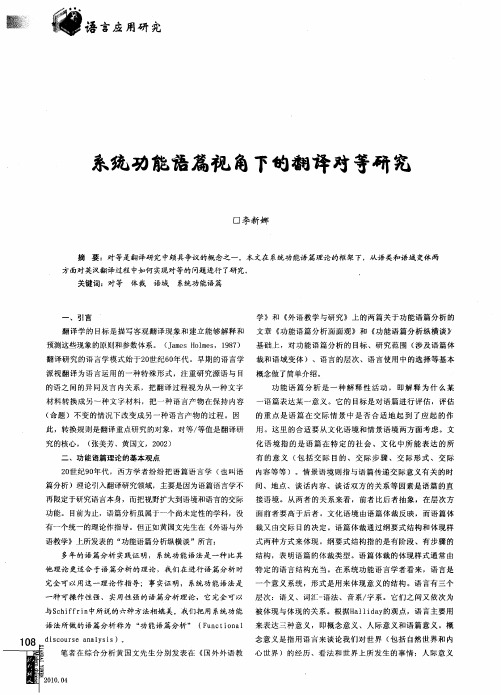
语教学》上所发表的 “ 功能语篇分析纵横谈”所言:
式 两 种 方 式 来 体 现 。纲 要 式 结构 指 的 是 有 阶 段 、 有 步 骤 的
多年 的语 篇分析 实践证 明,系统功能语法是一种 比其 结 构 ,表 明语 篇 的 体 裁 类 型 。语 篇体 裁 的 体 现 样 式 通 常 由 他理论 更适合 于语 篇分析的理论 ,我们在进行语篇 分析时 特 定 的语 言 结 构 充 当 。在 系 统 功 能 语 言 学 者 看 来 ,语 言 是 完全可以用这一理论作指导 ;事实证 明 ,系统功 能语 法是
此 , 转换 规 则 是 翻 译 重 点研 究 的 对 象 , 对等 / 值 是翻 译 研 用 。这里 的合适要 从文化语境和情景语境两 方面考虑 。文 等 究 的核 心 。 ( 张美 芳 、黄 国文 ,2 0 ) 02 二 、 功能 语 篇理 论 的 基本 观 点 化 语 境 指 的 是 语 篇 在 特 定 的 社 会 、 文 化 中所 能 表 达 的所 有 的 意 义 ( 括 交 际 目 的 、 交 际 步 骤 、 交 际 形 式 、 交 际 包
笔者 在 综 合 分 析 黄 国文 先 生 分 别 发表 在 《 国外 外 语 教 心 世 界 ) 的经 历 、看 法 和 世 界 上 所 发 生 的事 情 ; 人 际 意 义
2 0 0 01 . 4
语 言应 用研 究
是 指 用 语 言 来 与 别 人 交 往 , 建 立 或 保 持 与 别 人 的 关 系 ,影 《 技 英 语 学 习 》 曾刊 登 过 ~ 篇 英 文 报 道 , 标 科 n
一
一
个 意 义 系统 , 形 式 是 用 来 体 现 意义 的 结 构 。语 言 有 三 个
种 可操 作 性 强 、 实用 性 强 的语 篇 分 析 理 论 , 它完 全 可 以 层 次 :语 义 、 词汇 一 法 、 音 系/ 系 。 它 们 之 问 又 依 次 为 语 字
浅析语篇分析在翻译中的应用
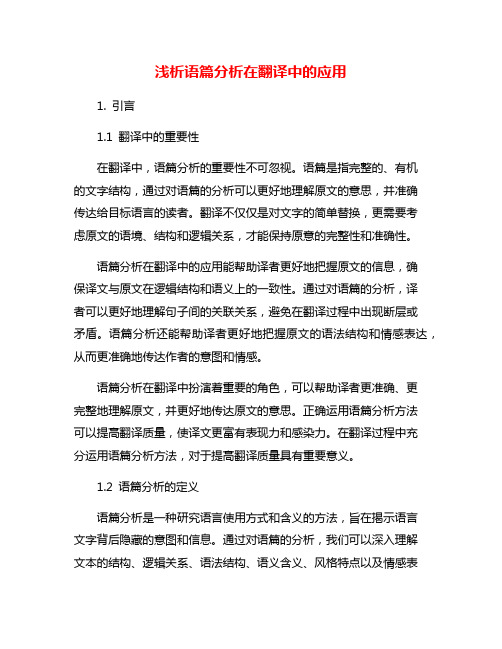
浅析语篇分析在翻译中的应用1. 引言1.1 翻译中的重要性在翻译中,语篇分析的重要性不可忽视。
语篇是指完整的、有机的文字结构,通过对语篇的分析可以更好地理解原文的意思,并准确传达给目标语言的读者。
翻译不仅仅是对文字的简单替换,更需要考虑原文的语境、结构和逻辑关系,才能保持原意的完整性和准确性。
语篇分析在翻译中的应用能帮助译者更好地把握原文的信息,确保译文与原文在逻辑结构和语义上的一致性。
通过对语篇的分析,译者可以更好地理解句子间的关联关系,避免在翻译过程中出现断层或矛盾。
语篇分析还能帮助译者更好地把握原文的语法结构和情感表达,从而更准确地传达作者的意图和情感。
语篇分析在翻译中扮演着重要的角色,可以帮助译者更准确、更完整地理解原文,并更好地传达原文的意思。
正确运用语篇分析方法可以提高翻译质量,使译文更富有表现力和感染力。
在翻译过程中充分运用语篇分析方法,对于提高翻译质量具有重要意义。
1.2 语篇分析的定义语篇分析是一种研究语言使用方式和含义的方法,旨在揭示语言文字背后隐藏的意图和信息。
通过对语篇的分析,我们可以深入理解文本的结构、逻辑关系、语法结构、语义含义、风格特点以及情感表达。
在翻译领域中,语篇分析扮演着至关重要的角色,帮助译者更好地把握原文的意思和情感,并将其准确传达到目标语言中。
语篇分析的定义涉及到诸多方面,包括从宏观层面上对整个语篇的结构和内容进行分析,到微观层面上对具体句子和词语的语义和语法进行解读。
通过对语篇的深入分析,翻译者可以更好地理解原文作者的意图和表达方式,从而更准确地传达文本的含义和情感。
语篇分析在翻译中的应用至关重要,对于提高翻译质量和效果具有重要意义。
2. 正文2.1 语篇分析在翻译中的应用语篇分析在翻译中的应用是非常重要的,它可以帮助译者更好地理解源语言的意思,进而更准确地将其表达出来。
通过语篇分析,译者可以把握文本的整体结构和逻辑关系,从而避免在翻译过程中出现断裂或不连贯的情况。
从语篇分析的角度看翻译中的对等

从语篇分析的角度看翻译中的对等一、本文概述翻译作为一种语言间的交流活动,其核心在于如何在保持原文意义的基础上,用另一种语言准确、流畅地表达出来。
在这个过程中,翻译对等性一直是一个重要而复杂的问题。
本文将从语篇分析的角度出发,探讨翻译中的对等性问题。
我们将对语篇分析的基本概念进行介绍,然后阐述翻译对等性的内涵及其在翻译实践中的重要性。
接着,我们将通过具体案例,分析在翻译过程中如何实现不同语言间的对等性。
我们将总结在语篇分析视角下,提高翻译对等性的策略和方法,以期为翻译实践提供有益的参考。
通过本文的探讨,我们期望能够帮助读者更深入地理解翻译中的对等性问题,提高翻译质量和效果。
二、语篇分析理论框架在翻译研究中,对等是一个核心概念,旨在寻求源语和目标语之间的语义、风格和功能的对等。
然而,对等并非简单的逐字逐句对应,而是需要在更大的语境——即语篇的层面上进行理解和实现。
这就引出了语篇分析理论框架在翻译研究中的重要性。
语篇分析理论框架为我们提供了一个全面、系统的视角,使我们能够在更大的语境中理解和处理翻译中的对等问题。
该框架主要包括三个层面:微观结构、中观结构和宏观结构。
微观结构关注的是语言的基本单位,如词汇、短语和句子。
在这一层面,翻译者需要关注源语和目标语之间的语义对等,确保翻译在词汇和句子层面上能够准确地传达原文的含义。
中观结构则关注语篇的连贯性和衔接性。
翻译者需要分析源语语篇中的信息流动和逻辑关系,然后在目标语中重建这种流动和关系,确保翻译在整体上保持连贯和一致。
宏观结构则涉及到语篇的语境和目的。
翻译者需要理解源语语篇的社会文化背景和交际目的,然后在目标语中创造出符合这些背景和目的的翻译,确保翻译在功能上与原文对等。
在这个理论框架下,翻译不再是一个简单的语言转换过程,而是一个涉及到文化、社会、心理等多个层面的复杂过程。
翻译者需要在这个过程中充分发挥自己的主体性和创造性,寻求源语和目标语之间的最佳对等。
浅析语篇分析在翻译中的应用

浅析语篇分析在翻译中的应用
语篇分析是指对一篇完整的语言材料进行分析,包括句子、段落和篇章等层次,以获取更为全面、准确的语言信息。
在翻译过程中,语篇分析可以帮助翻译者更好地把握原文的语言风格、段落结构、篇章脉络等信息,进而做出更为优秀的翻译。
具体来说,语篇分析在翻译中的应用有以下几个方面:
1. 揭示原文语言风格:语篇分析可以帮助翻译者了解原文的语言风格和表达方式,包括文体、语气、语调等。
指导翻译者在翻译过程中评估译文的语言风格,使翻译文本更加接近原文的风格。
2. 把握原文段落结构:语篇分析可以帮助翻译者理解原文的段落结构,了解每个段落的中心思想、逻辑关系和转换方式。
有助于翻译者在翻译过程中合理划分段落,确保译文不仅语言准确,而且结构合理。
3. 把握篇章脉络:语篇分析可以帮助翻译者了解原文的篇章脉络和主题、结构和发展。
有助于翻译者在翻译过程中把握原文主题,确保译文在语言和内容上完整且精准。
4. 提供翻译思路:语篇分析可以帮助翻译者预测原文中可能出现的语言难点,有助于翻译者掌握翻译重点,提供翻译思路,减少翻译过程中的疑惑和迷茫。
5. 辅助翻译审校:语篇分析可以帮助翻译者对比原译文本,发现翻译中存在违反原始段落结构、篇章脉络,差错浅易的情况,有助于翻译审校,确保最终翻译成果的质量和准确性。
总之,语篇分析在翻译中发挥着重要的作用。
熟练掌握语篇分析,可以帮助翻译者更好地把握原文的语言信息,提高译文质量,减少翻译过程中的疑惑和困难。
同时,全面、准确的语言信息提取,也有助于翻译者提升翻译能力,进一步提高翻译质量。
浅析语篇分析在翻译中的应用

浅析语篇分析在翻译中的应用1. 引言1.1 引言语篇分析在翻译中扮演着非常重要的角色。
通过对原文中的语篇结构、语言特点以及语言功能的分析,我们可以更好地理解原文的意思和作者的意图,从而更准确地进行翻译。
语篇分析不仅仅是对文字的理解和解释,更是对文本背后所隐藏的文化、社会和语言信息的解读。
在翻译过程中,语篇分析可以帮助译者更好地把握原文的整体结构和逻辑关系,帮助译者更好地选择合适的翻译策略和方法。
通过语篇分析,译者可以更好地处理原文中的隐晦意义、语言搭配和篇章连接,从而使译文更加流畅、自然地传达原文的意思。
2. 正文2.1 语篇分析在翻译中的重要性语篇分析在翻译中的重要性不可忽视。
语篇分析是翻译过程中至关重要的环节,它帮助翻译者更好地理解原文的意义和情境,从而保持原文的信息和语境完整性,确保译文与原文一致。
语篇分析可以帮助翻译者把握原文的语言特点和篇章结构。
通过对原文的语言风格、逻辑结构、语义关系等方面进行分析,翻译者可以更好地理解原文作者的意图和表达方式,从而更准确地翻译原文。
语篇分析可以帮助翻译者解决原文中的歧义和难点。
在翻译过程中,原文可能存在多种不同的解释和理解方式,翻译者需要通过语篇分析来确定最合适的翻译策略,以确保译文贴近原意。
语篇分析还可以帮助翻译者克服语言和文化差异带来的困难。
通过深入分析原文所处的语言和文化环境,翻译者可以更好地把握原文的内涵和外延,避免翻译过程中出现理解偏差或语言错误。
语篇分析在翻译中扮演着至关重要的角色。
只有深入理解原文的语言特点和篇章结构,翻译者才能准确地传达原文的意义和情感,确保译文与原文一脉相承。
翻译者在进行翻译工作时,务必重视语篇分析的重要性,将其作为翻译过程中不可或缺的一环。
2.2 语篇分析在翻译中的具体应用在翻译过程中,语篇分析可帮助译者理解原文的语篇结构和逻辑关系,从而更准确地传达原文的意思。
通过对原文的段落结构、句子连接和语段衔接进行分析,译者可以更好地把握原文的整体信息,避免翻译出现断裂和不连贯的情况。
翻译中的“语篇对等”

次 起 作 用 的 , 有 一 种 占主 要 地 位 的修 只
在 翻 译 单 位 结 构 中 , 篇 是 结 构 的 最 辞 目的 。 就是 语 篇 的 主 导 性语 境 聚 焦 点 。 语 这
实 际上 从 属 于 语 篇 的总 体 功 能 。 譬如 说 , 在 新 闻报 道 里 , 虽然 会 有 评 判 性话 语 , 主导 但
时 字 层 面或 句 层 面 的 对 等 就 陷 入 困 境 , 只 起 到 为 某 一 个 总 体 修 辞 目的 服 务 的 作 用 性 聚 焦 点 始 终 是 在 各 种 相 关 事 件 的 序 列
有 语 篇 对 等 才 能 解 决 问题 , 把 整 个 语 篇 ( 蒂 姆 、 即 哈 梅森 ,0 5 2 4 。 可 长 可短 , 2 0 : 7 )它 短 上 。 作 为一个 翻译 单位 。 二句 话 “ h s i n t 的 三 言 两语 , 的 洋 洋洒 洒 一 泻 千 里 , 键 第 T i s o 长 关 因 此 , 追 求 翻 译 过 程 中 的 “ 篇 对 在 语 syn c ” a i mu h 是承 上启下 的关 键句 I hs复 是 意 义 完 整 , 后 连 贯 , g T i 前 自成体 系 。 译者 等 ” , 要 搞 清语 篇 的 多 功 能 性 , 定 语 对 时 先 确
1 对等 : 词层面 、 旬层面还是 “ 语篇层面 ”
在 翻 译 过 程 中 , 者 将 词 和 短 语 当 作 译
自 己的 原 材 料 ; 典 和 参 考 资 料 只发 生 在 词
( e’ c n mit4. 1 1 8 ) Th E o o s , 0 . 9 6
类 型 划 分 建 基 于他 自己所 称 的 主导 性 的 语
文化语境对语篇翻译对等的制约——以外宣公示语篇为例

际功 能 对 等 上 。
o utr) t eue来体现的 。例如 , r 当一个语篇正
文 的 第 一 句 是 “ 位 领 导 ,各 位 嘉 各 宾 ……” , 时 中国人便 明 白这是一个会 议 或仪式活动 的开场 ;而英 语 国家人 士会
策略 , 保持译文功能与原 文功 能的对等 。
s utr)和 “ 现 样 式 ” ra zt) l tc e r u 体 (ela h i ka
的中国语言文化特色 。政府对 外宣传的
目的 是 让 那 些 对 中 国 国情 不 了解 的 受 众
在这些 理论 的结合 和演进 过程 中 ,
现 样 式 的 变化 。文 化 语 境 对翻 译 语 篇 的
语 篇总是置身于两种语境 之 中:情景语
境 与 文化 语 境 。
对 等性 产 生制 约 , 由 此 引 起 的 翻 译 中 的
在文化语 境下进行 的具体的语言 交 际运 用 , 就是 情 景语 境 (o t t fi a cne t — x o su tn , 文化语境现实化 的表现 。情景 语 i )是 o
…
一
g
i
文化 语境对语篇翻译对 等的制 约
以外宣公 示语篇为例
口广西大学 任 蓉
可 以用 下 图来 表 示 : 功 能 语 言 学 关 注 的是 语 言 的交 际功
【 摘
要】 通过对酒店 禁烟 公示语篇
功能 ,讨论由于文化语境 的变化而 引起
的 翻 译 “ 对 等 ” 现象 。 不 的
境 主要 因语言使 用形式 的 不同 而引起 ,
浅谈语篇分析视角下英语翻译及其应用_

浅谈语篇分析视角下英语翻译及其应用摘要:把握语言的翻译本质,采用基于语篇分析理论和手段有助于在语篇理解过程中实现功能对等,指导语篇认知与理解,促使在体验中感悟到语言学习的乐趣,从而激发学习兴趣。
本文主要阐述语篇分析视角下英语翻译及其应用。
关键词:语言语篇理解翻译与此相应的是传统的英语翻译只注重词、句的翻译,并集中于词汇、语法和专业内容三个方面,这些理论自然有其价值,然而在翻译的对象常常是语篇这一有机整体的情况下,容易造成只见树木不见森林的片面性以及翻译的机械主义通病。
语篇分析的兴起为研究英语翻译提供了新的途径。
1语篇分析的过程语篇过程是把多维的世界、抽象的概念,同时并存的状态或同时发生的事件线性化的过程。
由于语言符号与思维对象之间的象似性,语言符号的能指与所指之间所存在的自然联系,主位结构、信息结构与衔接结构才能彼此照应,保障语篇语义的自然顺序的推进,形成不同的主位推进模式。
语言的翻译对研究语篇中主位推进模式语义的发展提供了新的视野。
客观世界是人们体验和认知的基础,认知是人们对客观世界感知与体验的过程,语言是客观世界、人类认知、社会文化等因素相互作用而产生的一套复杂的符号系统,是客观现实、身体体验、人类认知、生理基础等多种因素综合的结果,因而语言符号的能指即语言形式和所指(包括现实世界、经验结构、概念系统、所表意义)之间存在象似性,它是语言符号在音、形或结构上与其所指之间存在映照性相似的现象。
2语篇分析在英汉翻译的应用语篇的建构是言语活动和认知心理活动的综合,不仅存在于语音和句子结构方面,还存在于语篇中,并对语篇的衔接与连贯起着重要的作用。
由于英语句法结构上可以层层修饰,句中套句,加上插语等形式,可以形成复杂的长句。
翻译时往往难以下手。
从语篇分析角度分清各从句及词组的修饰关系,这样就可以从意思上分清层次,弄清其逻辑关系和时间地点等的顺序,然后按照汉语的特点和表达方式,正确地、层次分明地译出。
原意不要拘泥于原文的形式。
翻译对等理论
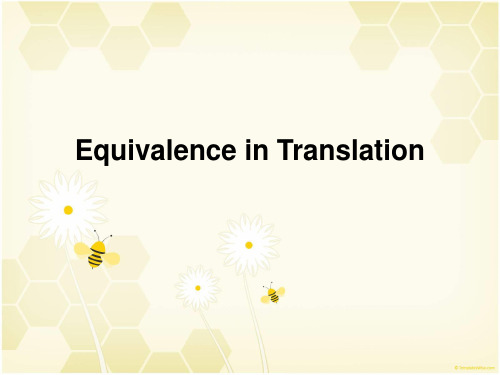
奈达:������ 形式对应������ (formal correspondence)和动态对等������ (dynamic equivalence) • 奈达翻译理论形成于20 世纪60年代并于80年代介绍到中 国, “功能对等”是他的中心翻译思想之一 • 1964年, 奈达在《翻译科学探索》中首次提出了“动态对 等”的概念, 提出将翻译研究的重点从对静态的文本信息 的关注转移到读者对文本动态信息的关注。 在1969年的《翻译理论与实践》中, 奈达再次定义说: “ 动态对等就是译文读者对译文所作出的反应与原文读 者对原文所作出的反应基本一致”。 这里的动态对等就是指功能对等
三、翻译对等的类型
There are three types of translation equivalence: Stylistic equivalence socio-cultural equivalence linguistic equivalence:is divided into pragmatic,semantic,and grammatical equvilence,the highest priority is credited to pragmatic equvialence and then semantic equivalence has priority over grammatical equivalence
The major theory
1.雅各布逊和他的“差异中的对等”
雅各布逊在他名为《论翻译的语言学观������ 》 (1959)这篇文章中,论述了三 种翻译类型:语际(interlinguistic)翻译、语内(intralinguistic)翻译和语符翻译 (intersemiotic)(Jakobson1959)。他认为在语内翻译时,译者为了清楚地表达 信息,可以使用同义词,这就意味着语码单位之间通常没有完全的对等,从语 法的角度来看,语言本身存在差异,译者翻译时可能面临找不到对应词语的问 题,但这并不意味着语言不可译。他承认������ 专有名词可以用外来语(loan words)、直译语(loan translation)、新语(neologism)、语义转换(semantic shifts)和迂回表达法(circum locutions)等来引述������ (Jakobson1959:)。他强 调译者在翻译过程的重要地位,认为在没有与原文词、句对应的情况下,就该 由译者来选择最合适的方法进行翻译。由此可见,雅各布逊的理论是以符号学 为基础的,译者首先对源语信息进行编码,然后再把它转换成目的语相应的信 息。
动态对等翻译
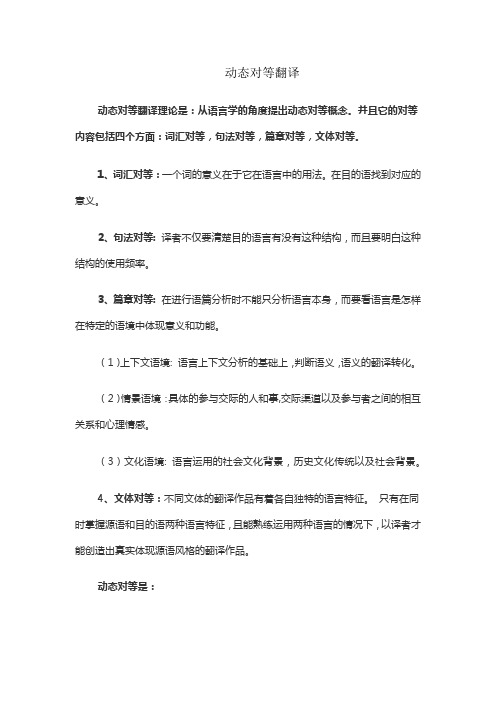
动态对等翻译动态对等翻译理论是:从语言学的角度提出动态对等概念。
并且它的对等内容包括四个方面:词汇对等,句法对等,篇章对等,文体对等。
1、词汇对等:一个词的意义在于它在语言中的用法。
在目的语找到对应的意义。
2、句法对等: 译者不仅要清楚目的语言有没有这种结构,而且要明白这种结构的使用频率。
3、篇章对等: 在进行语篇分析时不能只分析语言本身,而要看语言是怎样在特定的语境中体现意义和功能。
(1)上下文语境: 语言上下文分析的基础上,判断语义,语义的翻译转化。
(2)情景语境:具体的参与交际的人和事,交际渠道以及参与者之间的相互关系和心理情感。
(3)文化语境: 语言运用的社会文化背景,历史文化传统以及社会背景。
4、文体对等:不同文体的翻译作品有着各自独特的语言特征。
只有在同时掌握源语和目的语两种语言特征,且能熟练运用两种语言的情况下,以译者才能创造出真实体现源语风格的翻译作品。
动态对等是:“动态对等”是指“与源语信息最切进而又自然的对等”,它包含三层意思:(1)对等,针对源发语信息(翻译的根本任务是求得译文与原文的对等)。
(2)自然,针对接收者语言(使译文行文自然,不带翻译腔)。
(3)最切近,以最高近似值为基准,将前两种取向结合在一起(不论是语内交际还是语际交际,两篇不同的话语之间并无绝对对等可言)”。
并且“动态对等”的核心就是“接受者对转达到接受者语言中的原文信息的反应,大体上应与原文接受者的反应一样”。
也就是说,翻译的目标是使表达完全自然,这种自然除了指语言通顺,还包括适应读者的文化和思想习惯,并不要求读者对源语的文化有所了解。
1. 所谓动态对等的翻译,实际上就是翻译交际理论指导下的翻译,具体说来就是指“从语义到语体,在按受语中用切近原文的自然对等语再现源语信息。
”2. 重点:①自然,指译文不能有翻译腔②切近,指在“自然”的基础上选择意义与原文最接近的译文③对等,这是核心,“自然"也好,“切近”也好,都是为了寻找对等语服务的。
浅析语篇分析在翻译中的应用
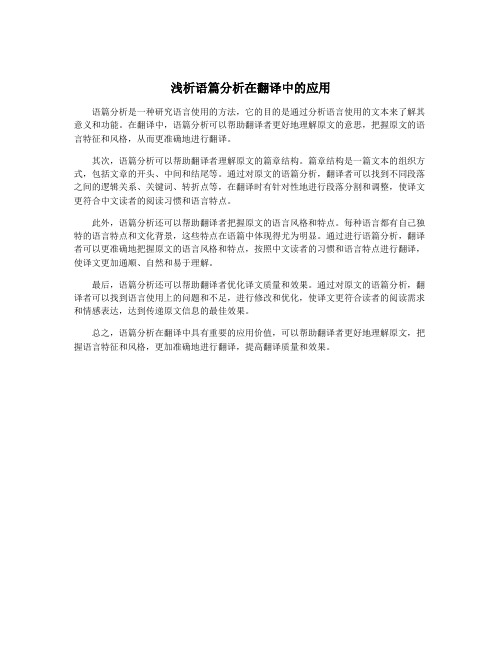
浅析语篇分析在翻译中的应用
语篇分析是一种研究语言使用的方法,它的目的是通过分析语言使用的文本来了解其意义和功能。
在翻译中,语篇分析可以帮助翻译者更好地理解原文的意思,把握原文的语言特征和风格,从而更准确地进行翻译。
其次,语篇分析可以帮助翻译者理解原文的篇章结构。
篇章结构是一篇文本的组织方式,包括文章的开头、中间和结尾等。
通过对原文的语篇分析,翻译者可以找到不同段落之间的逻辑关系、关键词、转折点等,在翻译时有针对性地进行段落分割和调整,使译文更符合中文读者的阅读习惯和语言特点。
此外,语篇分析还可以帮助翻译者把握原文的语言风格和特点。
每种语言都有自己独特的语言特点和文化背景,这些特点在语篇中体现得尤为明显。
通过进行语篇分析,翻译者可以更准确地把握原文的语言风格和特点,按照中文读者的习惯和语言特点进行翻译,使译文更加通顺、自然和易于理解。
最后,语篇分析还可以帮助翻译者优化译文质量和效果。
通过对原文的语篇分析,翻译者可以找到语言使用上的问题和不足,进行修改和优化,使译文更符合读者的阅读需求和情感表达,达到传递原文信息的最佳效果。
总之,语篇分析在翻译中具有重要的应用价值,可以帮助翻译者更好地理解原文,把握语言特征和风格,更加准确地进行翻译,提高翻译质量和效果。
从语篇分析理论看汉英语篇翻译中的衔接与连贯

从语篇分析理论看汉英语篇翻译中的衔接与连贯(总13页)--本页仅作为文档封面,使用时请直接删除即可----内页可以根据需求调整合适字体及大小--目录摘要 (i)Abstract.......................................................................................ii前言 (1)一、研究综述 (2)二、语篇的衔接 (3)(一)照应 (3)(二)省略 (4)三、语篇的连贯 (5)四、结语 (6)致谢 (7)参考文献 (8)从语篇分析理论看汉英语篇翻译中的衔接与连贯范海萍灵山县石塘镇大化小学袁学凤灵山县石塘镇大化小学摘要由于思想和文化的差异,汉语和英语这两种语言在句式上并不大相同。
语篇分析是系统功能语言学有别于其他语言学流派的重要特征,是理解语篇的要旨和深层意义的有效方法。
译者在进行翻译前,需要对语篇进行分析,只有做好语篇分析,才能真正懂得翻译,而衔接和连贯则是语篇的两个重要特征,在语篇翻译过程则是语篇连贯的识别与重构的过程。
本文以语篇分析理论中的衔接与连贯为理论依据,针对许地山著作《落花生》的两个英译本进行比较,并研究这两个英译本在衔接与连贯上的不同之处,最后给出处理这不同之处的方法与策略。
关键词:语篇分析; 街接; 连贯; 翻译Cohesion and Coherence in Chinese-English TextualTranslation from Text Analysis PerspectiveEnglish language special field 2013 Li YiyanInstructor Chen DongyanAbstractDue to differences in ideology and culture, both English and Chinese languages in the sentence is not the same. Discourse analysis is the characteristic of the systemic functionallinguistics,which is different from the other schools of linguistics, is to understand the tenor of discourse and the deep meaning of effective method. Before translation, translator need to analyze the discourse, only do a good job in discourse analysis, in order to really understand the translation, and the cohesion and coherence are two important characteristics of discourse, the discourse translation process is the process of recognition and reconstruction of discourse coherence. Based on cohesion and coherence in discourse analysis theory as the theoretical basis, according to Xu Dishan book compares the two English versions of "peanuts", and studies the two English versions on the cohesion and coherence of the difference, is given to deal with the difference method and strategy.Keywords: text analysis ; cohesive ; coherence ; translation前言语篇分析吸收了包括语言学、符号学、心理学、人类学、社会学、文学等学科的研究成果,慢慢形成了一个专门研究交际种语言使用情况的涉及到多个学科的一门学问。
斯坦纳阐释理论指导下的翻译中的语篇对等

斯坦纳阐释理论指导下的翻译中的语篇对等作者:丁梦颖来源:《西部论丛》2020年第02期摘要:本文在斯坦纳阐释理论指导下,通过对美国女作家凯特肖邦(Kate Chopin)的短篇小说《一小时的故事》(The Story of an Hour)的译文,分析它们在语义对等,风格对等,语篇对等方面的异同,探究英汉语篇翻译中对等的体现,以及在翻译实践中的运用价值。
关键词:阐释理论;语篇翻译;一小时的故事1.引言乔治·斯坦纳(George Steiner, 1929- )是当代英国著名学者,精通英、法、德三种语言,在英美多所大学任教,讲授语言学和翻译理论。
1.1 阐释理论概述斯坦纳对翻译的阐释学描述,或称“就意义的探究和对意义挪用性的转换”,是基于这样一种认识:翻译并非一门科学,而是“一门严谨的艺术”,极其精确但缺乏系统”。
阐释步骤(hermeneutic motion)构成了斯坦纳描述但核心,它共分四个部分:(1)起始阶段的信任(initiative trust); (2)入侵(aggression); (3)吸纳(incorporation); (4)补偿(compensation)。
在阅读或翻译之前,译者会自觉或不自觉地经历“信赖”这一步骤,他/她相信原文言之有物;“侵入”是指在理解原文时发生的两种语言、文化之间的冲突;“吸收”是指原文的意思和形式被移植,在引进的过程中,译入语可能变得丰富,也可能将源语同化;作者提出的最后一个步骤“补偿”至关重要,译者只有作出补偿才能恢复先前被打破的平衡,才能尽力达到理想的翻译。
1.2《一小时的故事》(The Story of an Hour)简介《一小时的故事》,是美國19世纪女性文学的代表作家凯特·肖邦(Kate Chopin)最知名的短篇小说。
小说描述了马拉德夫人的悲剧人生。
本文以《一个小时的故事》中译本为研究对象,从阐释理论的视角对比分析原文与译文的语言风格及语篇翻译的要素,力求在翻译过程中更好的实现语篇的对等转换。
翻译对等理论
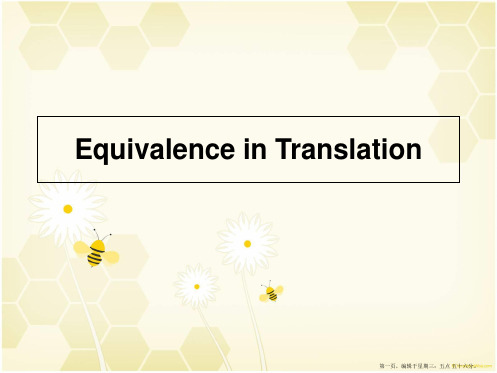
model,and scientific methods to analyze meaning in
his work on Bible translating.
3. Nida’s concepts of formal equivalence and dynamic
张美芳教授1999年在其论文“从语境分析看动态对等论的局限性
”中指出,奈达提出的“动态对等”存在某种程度上的缺陷。她
以分析查良镛先生写在香港回归之日的一篇文章为基础指出,在
下列情况下,“动态对等”不能取得:
“原文与译文的目的不一致时,其功能不可能对等;接受者
的文化背景和阅读经验不相同时,读者反应不可能对等;译语语
以使用同义词,这就意味着语码单位之间通常没有完全的对等,从语法的角度来看
,语言本身存在差异,译者翻译时可能面临找不到对应词语的问题,但这并不意味着语言
不可译。他承认 专有名词可以用外来语(loan words)、直译语(loan
translation)、新语(neologism)、语义转换(semantic shifts)和迂回表达法(circum
Equivalence in Translation
第一页,编辑于星期三:五点 五十六分。
Equivalence in Translation
一、什么是对等
二、对等理论的发展
三、翻译对等的类型
四、翻译界对对等理论的争论
第二页,编辑于星期三:五点 五十六分。
一、什么是对等
Equivalence refers to the description of one thing in different
- 1、下载文档前请自行甄别文档内容的完整性,平台不提供额外的编辑、内容补充、找答案等附加服务。
- 2、"仅部分预览"的文档,不可在线预览部分如存在完整性等问题,可反馈申请退款(可完整预览的文档不适用该条件!)。
- 3、如文档侵犯您的权益,请联系客服反馈,我们会尽快为您处理(人工客服工作时间:9:00-18:30)。
Modern Foreign Languages (Quarterly) Vol.24, No.1 January 2001: 78-84 Guangzhou, China Aspects of Translation from a Discoursal PerspectiveZHANG Mei-fangTranslation is a new discipline in academic terms. It is just starting to feature as a subject of study in its own right. Like other new disciplines, it needs to draw on the findings and t heories of other related disciplines in order to develop its own methods. But which disciplines it can be naturally and effectively related to is still a matter of some controversy.Linguistics is a discipline which studies language both in its own right and as a tool for communication. It should therefore have a great deal to offer to the budding discipline of translation studies. This is particularly true of functional linguistics which no longer restricts itself to the study of linguistic structure and phenomena, but extends itself to the study of language in use. In creating a new text out of a previously existing one, translators inevitably go beyond what is said and written in the original text, trying to see the context in which the text unfolds and in which it is to be interpreted. In studying this complex process at work, we are in effect seeking insights which take us beyond translation itself towards the whole relationship between language activity and the social context in which it takes place.This paper aims at introducing M.A.K. Halliday’s systemic functional linguistics to explain some aspects of translation. According to Halliday and Hasan (1989), language is either for action or for information, so it is organized by the function it is called on to serve and shaped by its purposes. All use s of language have a context. The textual features enable the discourse to cohere not only with itself but also with its context of situation which is analyzed by Halliday and Hasan into three components (field of discourse, tenor of discourse and mode of discourse), corresponding to the three metafunctions of language (ideational function, interpersonal function and textual function). Apart from the context of situation which is the immediate environment, there is also a broader background against which the text has to be interpreted: its context of culture. The context of culture is the institutional and ideological background that gives value to the text and constrains its interpretation.In this paper, the theory of context of culture and context of situation will be briefly examined and an English TEXT and its two Chinese versions will be analyzed. It is not the aim of this short paper to build any translation theory in relation to discourse analysis, but rather to look into detailed analysis for areas where the discoursal theory of language can bring insights to English/Chinese translation.Keywords: discourse analysis context of situation context of culturetranslation Correspondence: Department of EnglishSchool of Foreign LanguagesZhongshan UniversityGuangzhou,Guangdong 510275P .R .China<zhangmeifang28@>中国・广州现代外语(季刊)第24卷2001年第1期(总第91期):78-84 从语篇分析的角度看翻译中的对等张美芳翻译学是一个崭新的研究领域,需要利用相关学科的研究成果以建立自己的研究架构和研究方法。
然而,利用哪些相关学科理论以及如何利用这些理论,至今仍未有定论。
本文以韩礼德的系统功能语法为基础,从语篇分析的角度,在语篇体裁和语域变体两方面对英汉翻译中的问题进行分析,希望所运用的语篇分析理论能解释翻译中的一些现象及其“对等”与“非对等”问题。
关键词: 语篇分析文化语境情景语境翻译1. 引言M.A.K. Halliday曾经说过,“如果能用一个语言学模式来描写翻译过程,是非常有意义的。
我们应该根据语言活动本身的模式来描写,而不是以先入之见从语言研究领域外部去描写”(见Bell 1991:XVI)。
在过去十多年,西方一些语言学者努力尝试用功能语言学理论去探讨翻译中的问题。
例如,J. C. Catford(1965)以系统功能语言学为基础,提出了“翻译等值论”。
他认为,翻译实践的中心问题是寻求等值成分:等值关系可以在“层面”(levels, 语法、词汇、语音、词形等) 和“等级”(ranks, 语法结构、句子、短语、词、词素等) 的任何一个交叉点上建立。
B. Hatim 和I. Mason(1990;1997)以系统功能语言学中的语篇分析理论为依据,从交际的角度分析各种类型的文本及其译本。
R.T. B ell (1991)和M. Baker(1992)等学者也从系统功能学的角度提出了翻译研究的新途经。
然而,西方学者通常都不把汉语作为研究对象,这在一定程度上使中国读者对他们的理论敬而远之。
我国也有一些学者试图从语篇方面去讨论翻译问题(见李运兴1998,居祖纯1998,姚暨荣2000),把翻译研究从以句子为研究单位扩大到语篇。
有些学者也曾以Halliday 的语言学理论讨论翻译中的问题(见陈宏薇1996,张美芳1999),但大多数人在讨论语篇翻译时,只是从自己对语篇的理解进行分析,未能以一个经得起推敲的语言学模式来作为理论框架。
因此,到目前为止,对于语篇翻译的讨论仍然是众说纷纭,莫衷一是。
本文以韩礼德的系统功能语法为基础,从语篇分析的角度,在体裁和语域变体两方面对英汉翻译中的问题进行分析,希望所运用的语篇分析理论能解释翻译中的一些现象及其“对等”与“非对等”问题。
2. 关于语篇分析一般认为,语篇分析是一门新兴的、尚未定性的学科。
它没有一个单一的理论作指导,也没有公认的分析步骤和分析方法(见黄国文1988:7;Hatch 1992:1;Schiffrin 1994:1)。
美国著名语篇分析学者Schiffrin (1994) 在Approaches to Discourse 一书中介绍了六种可用于语篇分析的理论:言语行为理论(Speech act theory)、互动社会语言学 (Interactional sociolinguistics)、交际文化学 (the Ethnography of communication)、语用学 (Pragmatics)、会话分析 (Conversational analysis)、变异分析 (Variation analysis)。
系统功能语法的创始人M.A.K. Halliday 在An Introduction to functional Grammar (1985/1994) 一书中明确指出,他建构的功能语法的目的是为语篇分析提供一个理论框架,这个框架可用来分析英语中任何口头语篇或书面语篇。
